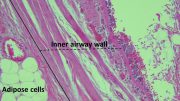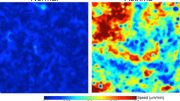
Asthma is a disease that can cause your airways narrow and swell as well as produce additional mucus.
Rather than merely treating its symptoms, a new strategy targets one of asthma’s causes.
Researchers from Aston University and Imperial College London have identified a potential method to address one of the fundamental causes of asthma. In experiments with mice, the researchers were able to virtually eliminate asthmatic symptoms and restore their airways to close to normal within two weeks.
In the UK, about 1,200 people die from asthma every year, and just under 5.5 million people get treatment for it. Asthma results in symptoms like wheezing and shortness of breath because the airways become thickened and constricted.
Current treatments, such as steroids, give temporary relief from these symptoms by relaxing the airways or decreasing inflammation. However, no existing medications target the structural changes that asthma causes in the airway and lungs in order to provide a more long-lasting treatment.
Lead researcher, Dr. Jill Johnson, from Aston University’s School of Biosciences, said: “By targeting the changes in the airway directly, we hope this approach could eventually offer a more permanent and effective treatment than those already available, particularly for severe asthmatics who don’t respond to steroids. However, our work is still at an early stage and further research is needed before we can begin to test this in people.”
The study focused on a kind of stem cell known as a pericyte, which is located primarily in the lining of blood vessels. When asthmatics have an allergic and inflammatory reaction, such as to household dust mites, the pericytes migrate to the airway walls. Once there, the pericytes mature into muscle cells and other cells that thicken and stiffen the airway.
This movement of the pericytes is triggered by a protein known as CXCL12. The researchers used a molecule called LIT-927 to block the signal from this protein, by introducing it into the mice’s nasal passages. Asthmatic mice that were treated with LIT-927 had a reduction in symptoms within one week and their symptoms virtually disappeared within two weeks. The researchers also found that the airway walls in mice treated with LIT-927 were much thinner than those in untreated mice, closer to those of healthy controls.
The team is now applying for further funding to carry out more research into dosage and timing, This would help them to determine when might be the most effective time to administer the treatment during the progress of the disease, how much LIT-927 is needed, and to better understand its impact on lung function. They believe that, should this research be successful, it will still be several years before the treatment could be tested in people.
Reference: “Chemokine CXCL12 drives pericyte accumulation and airway remodeling in allergic airway disease” by Rebecca Bignold, Bushra Shammout, Jessica E. Rowley, Mariaelena Repici, John Simms and Jill R. Johnson, 13 July 2022, Respiratory Medicine.
DOI: 10.1186/s12931-022-02108-4
The study was funded by the Medical Research Council.










Be the first to comment on "Potential Long-Term Treatment for Asthma Discovered"